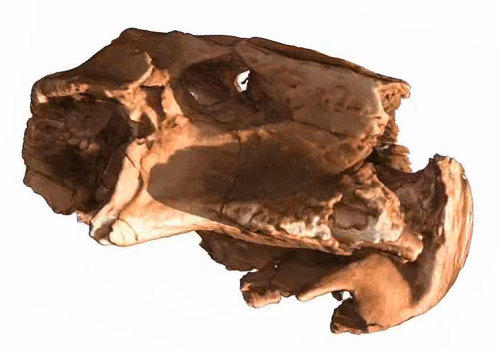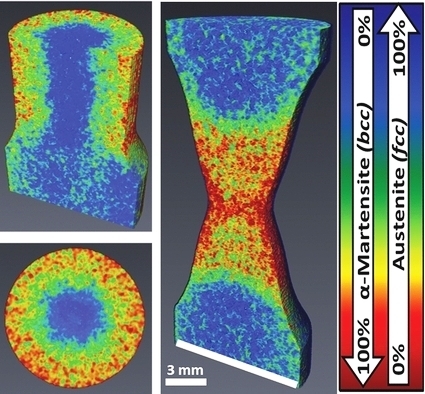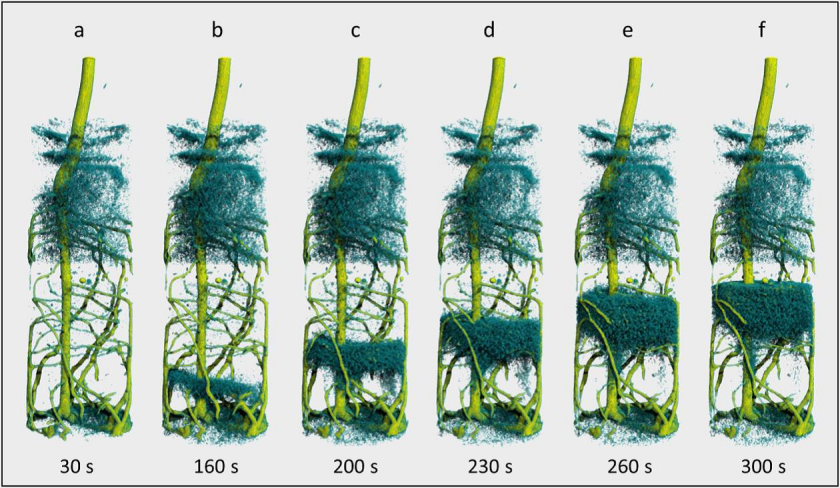Neutron tomography: Insights into the interior of teeth, root balls, batteries, and fuel cells

Fossils like this 250 million year old skull of a lystrosaurus can be examined very carefully by neutron tomography. © MfN Berlin

Neutron tomography shows how torsion (images left) and tensile forces (image right) are changing the distribution of different crystalline phases. © HZB/Wiley VCH

Sequential tomography of a lupin root (yellowish green) after deuterated water (D2O) was introduced from below. The rising water front (H2O, dark blue) is displaced by the D2O from below over the course of time. ©Christian Tötzke/ University of Potsdam
A team of researchers at Helmholtz-Zentrum Berlin (HZB) and European Spallation Source (ESS) has now published a comprehensive overview of neutron-based imaging processes in the renowned journal Materials Today (impact factor 21.6). The authors report on the latest developments in neutron tomography, illustrating the possible applications using examples of this non-destructive method. Neutron tomography has facilitated breakthroughs in so diverse areas such as art history, battery research, dentistry, energy materials, industrial research, magnetism, palaeobiology and plant physiology.
Neutrons can penetrate deep into a sample without destroying it. In addition, neutrons can also distinguish between light elements such as hydrogen, lithium and substances containing hydrogen. Because neutrons themselves have a magnetic moment, they react to the smallest magnetic characteristics inside the material. This makes them a versatile and powerful tool for materials research. 2D or 3D images, called neutron tomographs, can be calculated from the absorption of the neutrons in the sample. A world-renowned team headed by Dr. Nikolay Kardjilov and Dr. Ingo Manke is working with BER II, the neutron source at HZB, to constantly expand and improve of neutron tomography methods.
In their review paper, the authors describe the latest improvements in neutron imaging and present outstanding applications. Improvements in recent years have extended the spatial resolution down into the micrometer range. This is more than ten times better than with typical medical x-ray tomography. Faster images are also possible now, which makes observing processes in materials feasible, such as the “in operando” measurements of a fuel cell during its actual operation that shows precisely how the water is distributed in it. This provides important information for optimising the design of the cell.
Applications range from observing the transport of lithium ions in batteries and strength analyses of industrial components, to examinations of teeth, bones, and the roots of plants, to non-destructive analyses of historical objects such as old swords and knights' armour in order to obtain information on historical manufacturing methods.
“Neutron tomography is extremely versatile. We are working on further improvements and hope that this method, which is in great demand, will also be available in modern spallation sources in the future”, says Nikolay Kardjilov.
Publication: Materials Today 2018; “Advances in neutron imaging”, Nikolay Kardjilov, Ingo Manke, Robin Woracek, André Hilger, John Banhart
DOI: 10.1016/j.mattod.2018.03.001
arö
https://www.helmholtz-berlin.de/pubbin/news_seite?nid=14831;sprache=en
- Copy link
-
Peat as a sustainable precursor for fuel cell catalyst materials
Iron-nitrogen-carbon catalysts have the potential to replace the more expensive platinum catalysts currently used in fuel cells. This is shown by a study conducted by researchers from the Helmholtz-Zentrum Berlin (HZB), Physikalisch-Technische Bundesanstalt (PTB) and universities in Tartu and Tallinn, Estonia. At BESSY II, the team observed the formation of complex microstructures within various samples. They then analysed which structural parameters were particularly important for fostering the preferred electrochemical reactions. The raw material for such catalysts is well decomposed peat.
-
The future of corals – what X-rays can tell us
This summer, it was all over the media. Driven by the climate crisis, the oceans have now also passed a critical point, the absorption of CO
2 is making the oceans increasingly acidic. The shells of certain sea snails are already showing the first signs of damage. But also the skeleton structures of coral reefs are deteriorating in more acidic conditions. This is especially concerning given that corals are already suffering from marine heatwaves and pollution, which are leading to bleaching and finally to the death of entire reefs worldwide. But how exactly does ocean acidification affect reef structures?
Prof. Dr. Tali Mass, a marine biologist from the University of Haifa, Israel, is an expert on stony corals. Together with Prof. Dr. Paul Zaslansky, X-ray imaging expert from Charité Berlin, she investigated at BESSY II the skeleton formation in baby corals, raised under different pH conditions. Antonia Rötger spoke online with the two experts about the results of their recent study and the future of coral reefs.
-
Long-term stability for perovskite solar cells: a big step forward
Perovskite solar cells are inexpensive to produce and generate a high amount of electric power per surface area. However, they are not yet stable enough, losing efficiency more rapidly than the silicon market standard. Now, an international team led by Prof. Dr. Antonio Abate has dramatically increased their stability by applying a novel coating to the interface between the surface of the perovskite and the top contact layer. This has even boosted efficiency to almost 27%, which represents the state-of-the-art. After 1,200 hours of continuous operation under standard illumination, no decrease in efficiency was observed. The study involved research teams from China, Italy, Switzerland and Germany and has been published in Nature Photonics.
